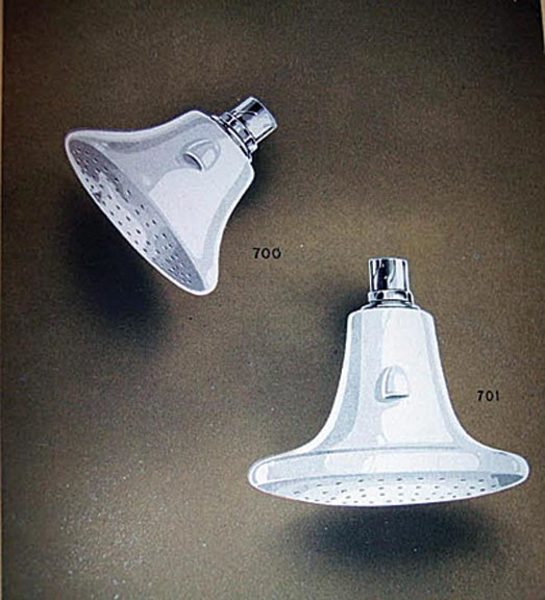Porcelain shower heads, like these from a Thomas Maddock & Sons catalog, had a spurt of popularity in the early 20th century.
I have an old porcelain shower head with a loose male threaded part. How do I tighten it so it won’t leak?
Don Hooper: It’s not uncommon for old bathroom fittings to be difficult to get apart, but in the decades I’ve spent restoring vintage bathroom parts, I’ve learned a few tricks that can help. In its present state, the fitting on your shower head cannot be tightened, and any effort to turn it will result in shattering of the china shower head (something you’ll obviously want to avoid). Fittings can become “frozen” together for a number of reasons. If they were originally assembled using plumber’s putty, it may have since turned to cement. (That’s why modern plumber’s putty is “guaranteed never to harden.”) Heat works well to mitigate this problem, because it will expand brass or iron parts enough to break their bond with the plumber’s putty. I like to use a small handheld propane torch with a fine, medium-heat flame for this purpose. However, before using heat you’ll need to disconnect the porcelain element, because when heated metal expands, it will also break any attached ceramics.
In the case of a shower head fitting that’s become loose, yet will not tighten or come apart, there is likely a different problem afoot. Brass fittings often have an internal part with locking “ears” that secure into a keyway cast in the top portion of the shower head. The internal and external parts of the metal fitting screw together with a rubber gasket in between, tightly fitting the china head. In this case, the rubber gasket can harden and shrink over the years, causing a leak. Extreme care and patience are needed to get the fitting out of the shower head in order to avoid shattering the fragile china. You’ll need to soften or dissolve the rubber gasket so that it no longer prevents the metal fitting from being disassembled from the head.
First, place the shower head in a container large enough to cover it with petroleum-based solvent, paint thinner, or WD-40. Immerse the head in a bath of one of these chemicals (which won’t damage the china or the brass fitting) and let it sit for several days; this should break down the gasket. Once the gasket has softened, the fitting can be carefully turned counterclockwise, and the metal internal locking “ears” removed from the china head. After the brass fitting is removed from the china head, it can be heated (as mentioned previously), then unscrewed.
When you’re ready to reassemble, you can cut a new gasket by hand from rubber gasket stock readily available at any hardware store. Before reassembling, clean all parts well and apply a penetrating oil (like Liquid Wrench) to the threads of the fitting. Next, install the new gasket, fit the ears of the internal part back into the head, and tighten the external part of the fitting onto the gasket until it’s snug. You shouldn’t have any more leaks.
Don Hooper owns Vintage Plumbing Bathroom Antiques and has been collecting, buying, selling, and restoring antique bathroom fixtures for 35 years.







